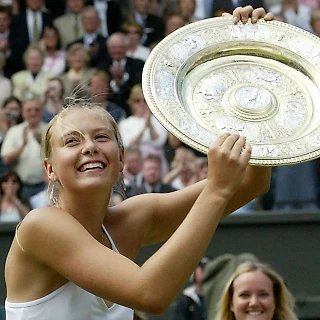The Maria Sharapova Fan Experience
By Lautaro Grinspan
Everyone has scenes they can replay in their heads with the most accurate of detail. It’s as if, for the span of however long memory, or perhaps impression, allows, our human minds metamorphose into television-like apparatuses and all we have to do is hit play and click! just like that a specific chain of events gets recalled as if they had happened yesterday. As if they had been the only thing we ever really paid any attention to, and the rest is all one big shapeless blur.
The specific “scene” in question, needless to say, varies from person to person, as individual experiences, affinities, backgrounds and, quite possibly, childhood traumas all come into play. Just as some might see, say, the dramatic climax of their favorite film, others might visualize a life-altering event such as their wedding, or their first collegiate laundry day. The point is (make that “point” I’m not overly sure where I’m going with this), we’re all different.
Now, what do I see in constant, surprisingly-HD replay when I visit my inner cinema? What gif-like scene haunts my brain, its never-ending loop granting no momentary respite?
Irrevocably, I see Maria Sharapova, my favorite female tennis player, in the midst of her by-now-surely-iconic-pre-serve routine. I see her turning her back to her opponent, gazing deeply into her stick’s strings, as if hoping to find the very meaning of life in the grid pattern. I see her looking up to a ballboy–always the one to her left, mind you–and signaling for two balls.
Unlike others, she makes no fuss about the balls’ fuzz and takes whatever she’s given, no takesies or backsies involved. She places one of the balls in her dress’ pocket and, while still staring at her strings, she finally, almost reluctantly turns around. She strides towards the baseline, her long legs dragging her away from the back of court, and towards the place of battle, the place she and her insecurities and vulnerabilities won’t be able to hide out at anymore. Time in her mental shelter ran out. The bubble has burst.
She positions herself to serve, racquet in the right hand, a ball in her left. In a chain of events that, in despondent befuddlement, takes you back to hastily learned (and promptly forgotten) high school physics lessons (how can something dispatched from so high up fail to make it over the net), she dumps her first delivery.
Here we go, I mutter to myself, as I mentally prepare for the onset of The Anxiety. After one of the ballboys stationed by the net rises from his awkward kneel to clear the misfired ball, she makes the second ball resurface from her clothing’s folds. Don’t double fault. She looks up and directs a long, steady glance at her diagonally-located opponent, a rare acknowledgment of the latter’s presence (seemingly arising from a fairly naive attempt at intimidation). Is this really necessary?
She bends forward and, in a stocky, robotic motion makes the ball bounce twice. Bounce. Bounce. Don’t miss, Maria. She flails her arms to the skies, simultaneously taking her racquet back and, with an extended left arm, tossing the yellow ball at a hyperbolically high height. Here it comes. Keeping her eyes on the ball, she starts to uncoil and extend, exhorting herself upwards and onwards to meet the projectile at full stretch and with full force. Oh, god. The sweet spot of her Head racquet impacts the ball as a shriek begins escaping her lips. I hold my breath.
The phrase “the struggle is real” is slowly but (agonizingly enough) surely becoming one of those overused, hackneyed phrases that make one gnash one’s teeth in hard-to-repress rage and summon hatred for contemporary, foible-filled pop culture slang. However, TSIR, as I try to briefly summarize what the Maria Sharapova fandom experience is like, is the phrase that repeatedly and irrevocably comes into mind.
There’s, after all, the nightmare-inducing and mental-health-debilitating double faults. There’s the wild errors. There’s the propensity to injury, thanks to a particularly uncooperative right shoulder. There’s the less-than-sparkling record in finals (32-22), which naturally includes five (make that five) finals dropped in my “home” event of Miami.* And there’s the famously infamous, avert-your-eyes ugly, legacy-tarnishing record against Serena Williams, which currently stands at 16-2, with Maria going winless since 2004. All in all, you know you have it relatively bad when concerned (or slightly mocking?) relatives, referencing your fandom (and its attacks on your sanity) consistently squawk, Why do you this to yourself? Which is actually a good question (once the urge to scoff and eye-roll is suppressed).
So where, from which source does fandom for Maria Sharapova originate? Is it simply the masochists in us picking up the call? Or is there more to it? Why do we do this to ourselves?
Of course, I personally happen to think Sharapova’s fan appeal is quite multifaceted and of a deep, genuinely human nature (which, given I’ve set out to write a whole piece about it, should come as no surprise). In examining that perplexing and controversial appeal, I find, we discover as much about her as we do about us.
Maria as a racquet-swinging contradiction
What do, say, a right-leaning hippie and an EDM-loving grandfather have in common? Merely the fact that certain characteristics of their respective persons are unusual combinations, intrinsically contradictory by nature. But that element of strange contradiction doesn’t put off or repulse; rather, it poses questions, warrants attention and, ultimately, fascinates, its ability to underscore humanity’s great potential for, well, fun randomness always edging out any initial unsavoriness. And that is precisely where Sharapova’s mysterious appeal begins. Undeniably, she is a grunting, tennis-court-prancing, racquet-wielding, fascinating contradiction.
Consider this: she’s icy, in her I’m-not-here-to-make-friends attitude, but fiery, if her effusive fist pumps and war-cry-like “Come on!” are any indication. She is chockfull of outside interests, but remains staunchly committed to the tour and its various demands. She is a fit and lean professional athlete but one of entrepreneurial-Maria’s most recent ventures has been churning out bags of “premium” gummies and candies (she’s been on a Sugarpova high since 2012), with no signs of slowing down (which I mean mostly in a judging way, but I have to confess I double-thumbs-up approve of the Pinkberry partnership). She sounds immaculately American, and has claimed a US-residence the majority of her life, but professes enthusiastic love for her Russian motherland. And, last but not least, she looks every bit the dainty princess, Beauty personified one could even say, but she shows no hesitation over becoming a street-fighter, the Beast itself, when stepping on court. Which segues nicely to my next point …
Sharapova and the will to overcome ova-come
I hereby formally challenge anyone with Internet connectivity to try to find a single article concerning Sharapova that fails to include the word “fighter” in it. Or to sit through any broadcast of one of her matches without hearing multiple references to the famously infamous f-word. The reality is, that, while writers and TV commentators (especially the latter) can be guilty of mindless, automatic regurgitation of narratives and story lines, they’re absolutely and 100% correct when they call Maria an indefatigable fighter.
You can observe this quality of hers in both the micro sense (as in, fighting through individual matches as she did in seeing off four consecutive three-setters in this year’s French Open) and in the macro sense (as in, her career-long transformation from bovine clay-court-wannabe to two-time-RG-champion Claypova). Has anyone else, in dual-gender tennis, in all of sports, ever embodied more the definition of “competitor”? Has any athlete made more of an art-form of getting up when put down, managing pressure, overcoming struggles, swiping away disappointments and, yes, fighting as Maria?
At her core, at her most natural, most basic form, Sharapova isn’t a tennis player, but a fighter. And that’s uniquely inspiring because it’s uniquely relatable. Willpower and fighting spirit are, after all, things we can emulate and incorporate in our own lives (much more than, say, a hellacious kick serve or a mean forehand drop shot) as we counter our own struggles and setbacks, no matter how distanced from the tennis court those might be. Remember: what ultimately makes athletes respect-commanding figures worth looking up to is their attitude and not their physical prowess, their heart and not their mechanics.
She could not care less
In the age of “you do you,” there’s, for better or worse, a kind of deference towards those maverick-like individuals who exhibit no concern for much and just, for the lack of better words, do their thing. That cool aloofness, that nonchalant detachment, is something we can’t help but admire (perhaps reluctantly so, at times), if not outright yearn for. And Maria Sharapova, almost non-intuitively (as her never-ending portfolio of sponsorships shows a certain tolerance to “work with the system”), has that.
She couldn’t care less if your dainty ears happen to be put off by her grunting. It’s of no concern to her that you find her pace of play slow, her victory celebrations excessive or, (unfairly, I think) her power-game one-dimensional. She’ll simply continue to exert her brand of what could be called the Bartoli-factor, and perpetuate her ever-so-divisive idiosyncrasies and quirks, thank you very much. And that’s a major part of her fan appeal. No one quite marches to the beat of their own drum (or, in this case, eyebrow-raising roar) like Sharapova.
An acquired taste
A quick assessment of the comments sections of Tennis.com articles and of their (the not-for-the-faint-hearted comments sections’) ability to descend into unruly, brawl-prone, saloon-type hot messes quickly reveals Maria Sharapova has tons of “dem haters.” Enough to make jelly, as an Argentine saying about abundance goes. But, in an albeit nonconventional way, her ability to attract detractors makes her even more likable, and, as a fan of hers, you feel more sophisticated, more hipster-y, like you’re smart enough to get it, to consciously find beauty in the face of everyone else’s seemingly blind ignorance.
Just look at her playing style, for instance: to others’ purportedly “one-dimensional,” “ball-bashing” game, you see, and choose to fixate on, a particularly free-flowing backhand, pinpoint-like precision, breathtaking relentlessness and smooth power. So while it’s easier to like, for example, peRFect Roger Federer, it’s more special to like Maria because, and not in spite of, the greater effort and longer time necessary to get there. The fact that Maria isn’t for everyone elevates, and not in the least humiliates, her fans.
____________________________________________________________________
She misses the second serve. Double fault. She pushes it wide and there goes the point, just like that. You go through The Motions: you wince, you eye roll, you utter curses to the pitiless tennis gods.
But then she turns arounds, seemingly pressing a “clear history” button as she gazes at her strings and just shrugs it off like its nothing. Like a double fault somehow isn’t the most embarrassing, confidence-dissipating, opponent-boosting mistake one could commit in tennis. She slams a first serve, attacks with a crosscourt backhand and seals the point with a characteristic flourish: the forehand swing volley. She throws her hand in the air, and while forming a fist-pump bellows “Come on!” Shaking your head in a little bit of confusion, some disbelief and a lot of admiration, you can’t help but smile.
That is the Maria Sharapova fan experience. It’s actually pretty cool.
*I make no claims to magical powers, but I’d be remiss not to point out that, in my 4-year ballboying career at the Sony, Sharapova has not lost any of her matches with me on court. The one stinging exception is, of course, the 2013 final, but MS was firmly in control while my shift was going on (she was a set and a break up over mega-nemesis Serena Williams), only to NOT WIN A SINGLE GAME the second I reluctantly left the stadium to be replaced.
>
Просмотров всех постов блога на эту неделю:
Просмотров всех постов блога в этом месяце:
Просмотров всех постов блога в этом году:
Прим.: начало отчета просмотров - 21.04.2014








